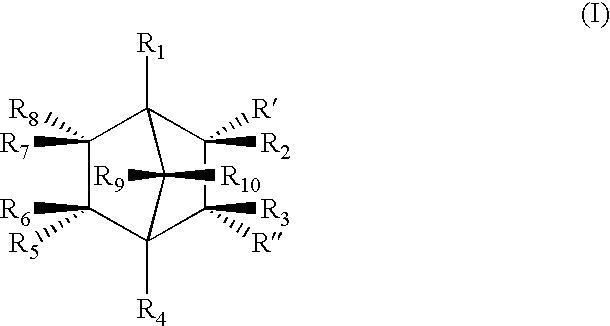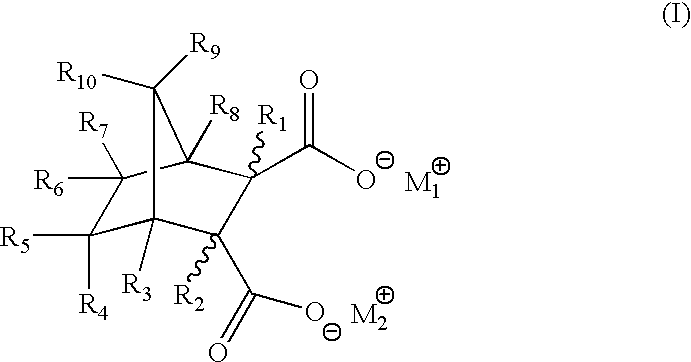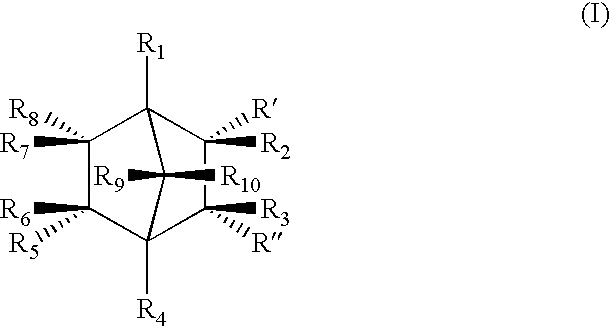Highly nucleated thermoplastic articles
a thermoplastic and high-number technology, applied in the field of thermoplastics, can solve the problems of nucleator compounds, each also exhibits its own drawback for large-scale industrial applications, and each also exhibits its own drawback for large-scale industrial applications, and achieves excellent calcium stearate compatibility, high nucleation efficiency, and low hygroscopicity.
- Summary
- Abstract
- Description
- Claims
- Application Information
AI Technical Summary
Benefits of technology
Problems solved by technology
Method used
Image
Examples
example 2
Calcium bicyclo[2.2.1]heptane-2,3-dicarboxylate
To a solution of disodium bicyclo[2.2.1]heptane-2,3-dicarboxylate (22.6 g, 0.1 mols) in water (150 g) was added a solution of calcium chloride dihydrate (14.7 g, 0.1 mols) in water (100 g). The mixture was stirred at 60.degree. C. for 2 hours. The resulting white precipitate was filtered. The white powdery product was dried and milled (m.p. >300.degree. C. ).
Other Group I and II salts, lithium, potassium, rubidium, magnesium, strontium, and barium salts of bicyclo[2.2.1]heptane dicarboxylates were synthesized through similar procedures of reacting a Group I or II salt with disodium bicyclo[2.2.1]heptane-2,3-dicarboxylate.
example 3
Hydrogen Sodium bicyclo[2.2.1]heptane-2,3-dicarboxylate
80.0 g (487.3 mmoles) of himic anhydride (164.16 g / mole) and 175 ml of water was charged into a 1L round bottom flask with stirring. To this solution was added 19.69 g (492.3 mmoles) of NaOH (40.00 g / mol). The solution was stirred with heat until all components were in solution. Upon cooling, crystals began to form and 500 ml of water was added to fully solubilize all solids. Palladium on activated carbon (5 wt % ) was added to the aqueous solution. The mixture was transferred into a Parr reactor and was subjected to hydrogenation (50 psi, room temperature) for 8 hours. The activated carbon was filtered out, and the water was removed in vacuo at 75.degree. C. The resulting product was dried and milled (m.p >300 C). An IR analysis was consistent with that of the expected structure. GS-MS showed >99% saturation of the double bond.
example 4
Hydrogen Lithium / Sodium bicyclo[2. 2.1]heptane-2, 3-dicarboxylate (Half Neutralized)
82.0 g (500.0 mmoles) of himic anhydride (164.16 g / mole) and 175 ml of water was charged into a 1L round bottom flask with stirring. To this solution was added 10.00 g (250.0 mmoles) of NaOH (40.00 g / mol) and 5.99 g (250.0 mmoles) of LiOH (23.95 g / mol). The solution was stirred with heat until all components were in solution. Half of this solution was transferred to another 1L round bottom flask. Upon cooling, palladium on activated carbon (5 wt % ) was added to the remaining aqueous solution. The mixture was transferred into a Parr reactor and was subjected to hydrogenation (50 psi, room temperature) for 8 hours. The activated carbon was filtered out, and the water was removed in vacuo at 75.degree. C. The resulting product was dried and milled (m.p >300.degree. C). An IR analysis was consistent with that of the expected structure. GS-MS showed >99% saturation of the double bond.
PUM
| Property | Measurement | Unit |
|---|---|---|
| thickness | aaaaa | aaaaa |
| thickness | aaaaa | aaaaa |
| peak crystallization temperatures | aaaaa | aaaaa |
Abstract
Description
Claims
Application Information
 Login to View More
Login to View More - R&D
- Intellectual Property
- Life Sciences
- Materials
- Tech Scout
- Unparalleled Data Quality
- Higher Quality Content
- 60% Fewer Hallucinations
Browse by: Latest US Patents, China's latest patents, Technical Efficacy Thesaurus, Application Domain, Technology Topic, Popular Technical Reports.
© 2025 PatSnap. All rights reserved.Legal|Privacy policy|Modern Slavery Act Transparency Statement|Sitemap|About US| Contact US: help@patsnap.com



